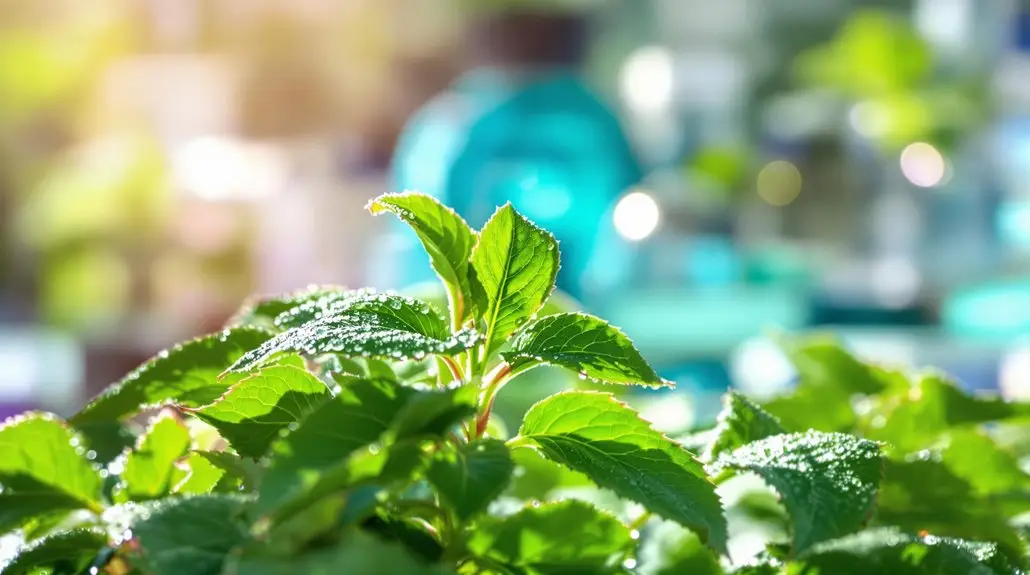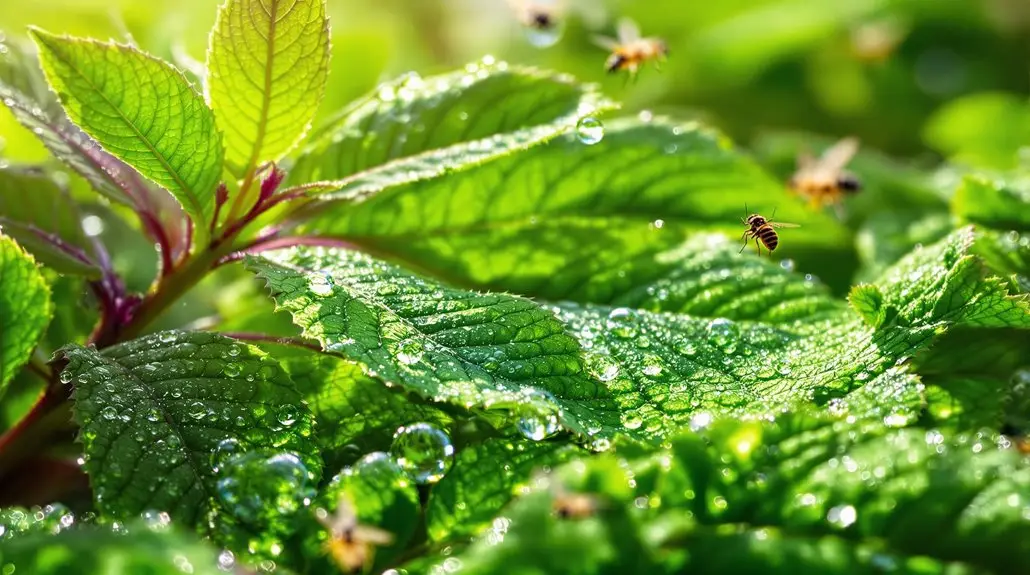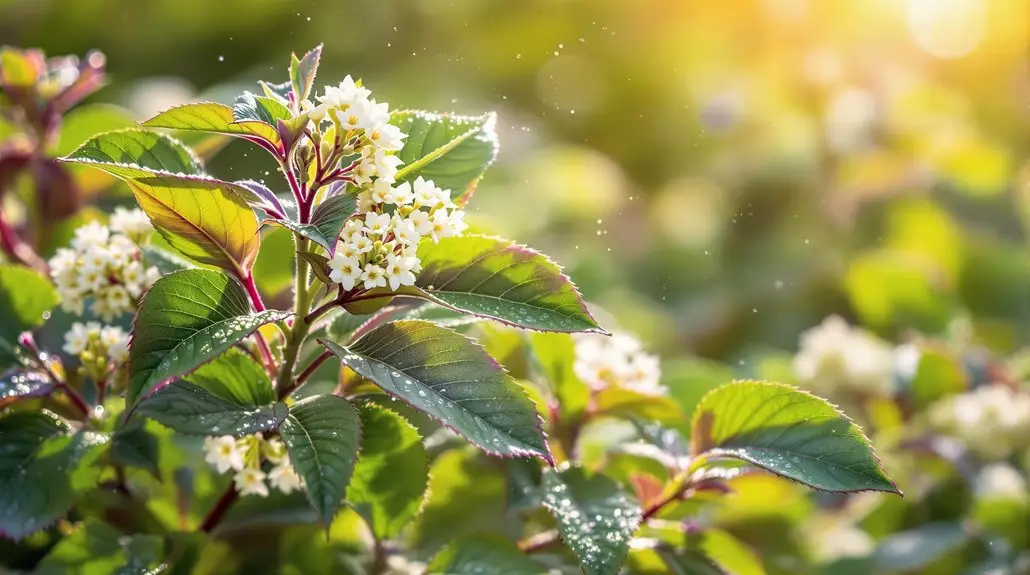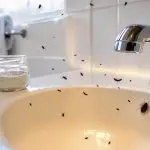Lippia origanoides, specifically the thymol and carvacrol chemotype, packs a punch when it comes to pesticide activity. It boasts impressive antimicrobial properties against bacteria and fungi, effectively inhibiting growth at low concentrations. This essential oil is also known for its insecticidal effects against pests like *Aedes aegypti* and *Myzus persicae*, showcasing significant repellency and mortality rates. Additionally, it exhibits phytotoxic effects on weeds, promoting sustainable agriculture. Seasonal variations in chemical composition may influence its effectiveness, making it vital to understand its application potential. Stick around to discover how this natural solution can transform your pest management strategies.
Key Insights
- Lippia origanoides essential oil primarily contains thymol and carvacrol, contributing to its significant pesticidal activity.
- The oil exhibits high insecticidal efficacy, achieving 100% mortality of pests like *Aedes aegypti* at 300 ppm.
- Antimicrobial properties include effective inhibition of bacteria such as *Staphylococcus aureus* and *Escherichia coli* at low concentrations.
- Seasonal variations influence essential oil yield, with higher production during the rainy season, impacting its pesticidal effectiveness.
- Integration of this essential oil into pest management strategies supports sustainable agriculture by reducing reliance on synthetic pesticides.
Chemical Composition Overview

What makes the chemical composition of Lippia origanoides so intriguing is its notable variability, which is influenced by factors like location, climate, and collection time.
When you explore the essential oil of this plant, you’ll find an array of major constituents such as thymol, carvacrol, p-cymene, and γ-terpinene. Each chemotype, whether it leans toward carvacrol, thymol, or p-cymene, reflects the unique environmental and genetic conditions it’s grown under, creating a rich tapestry of scents and potential benefits. Essential oil composition varies based on environmental factors and developmental stages, showcasing just how dynamic this plant can be.
You might be surprised to learn that even within the same chemotype, the composition can vary considerably. Different studies have classified chemotypes A, B, and C based on their predominant compounds, showcasing just how dynamic this plant can be. The diversity in chemical profiles aligns with the growing trend towards natural and organic pest control solutions in pest management.
The essential oil can also include other fascinating components like camphor and β-bisabolene, adding to its complexity.
Analytical techniques like gas chromatography (GC) and gas chromatography-mass spectrometry (GC-MS) play important roles in revealing the intricate chemical profiles of Lippia origanoides.
These methods help you identify and quantify various compounds, exposing a complex mixture of terpenes. As you dive deeper into the chemical composition, you’ll appreciate how each factor—be it plant age, collection time, or environmental influences—contributes to the oil’s overall character. Furthermore, the essential oil of Lippia origanoides is recognized for its antimicrobial properties, making it a promising candidate for natural alternatives to synthetic agents.
This exploration fosters a sense of connection, as you uncover the natural diversity that Lippia origanoides brings to the table.
Antimicrobial Properties
The antimicrobial properties of Lippia origanoides are as fascinating as its chemical composition. You’ll find that the essential oil of this plant is remarkably effective against various strains of bacteria and fungi, including *Staphylococcus aureus*, *Escherichia coli*, and *Candida albicans*. Research shows that at concentrations ranging from 5 to 20 μL/mL, it demonstrates significant bactericidal effects on *E. coli*, while 20 μL/mL is needed for *S. aureus*. The thymol and carvacrol chemotypes particularly shine, exhibiting impressive antibacterial activity. What’s more, the oil’s ability to inhibit biofilm formation is significant, with IC50 values under 250 µg/mL against most *S. aureus* strains. This means it can effectively disrupt bacterial communities that often resist treatment. You might appreciate that the antimicrobial activity is concentration-dependent; while no inhibition occurs at 100 μg/mL, higher concentrations (300, 600, and 900 μg/mL) show strong activity against the target strains. Recent studies have indicated that the chemical composition of L. origanoides EO directly influences its effectiveness against drug-resistant bacteria. Additionally, the Minimum Inhibitory Concentration (MIC) values for certain bacteria, such as *E. coli*, are notably low, ranging down to 0.1560 L/mL. The main players behind this antimicrobial action are the oxygenated monoterpenes, thymol and carvacrol. The effectiveness of the oil can vary based on its origin and chemotype, but overall, you can feel confident in the potential of Lippia origanoides as a natural antimicrobial agent. This makes it a valuable addition to discussions around sustainable and natural pest management strategies.
Insecticidal Effects

When exploring the insecticidal effects of Lippia origanoides, you’ll find notable adulticidal activity against various pests. The essential oil’s composition, particularly carvacrol and thymol, plays a key role in its efficacy. Additionally, the phytotoxic effects of L. origanoides may also contribute to its overall pest management capabilities. You’ll also notice impressive repellent efficacy measurements that highlight its potential for pest management strategies. Research indicates that the chemical composition of essential oils, including the significant presence of carvacrol, enhances their effectiveness against insect pests.
Adulticidal Activity Overview
Lippia origanoides stands out for its impressive adulticidal activity against various insect pests, particularly Aedes aegypti. This essential oil exhibits remarkable effectiveness, achieving 100% mortality at a concentration of 300 ppm after just 120 minutes of exposure.
If you’re looking for a natural solution to pest problems, this could be a game-changer.
Here’s what you should know about its adulticidal properties:
- Potent Efficacy: Kills all adult mosquitoes effectively at high concentrations.
- Comparative Advantage: One of the top performers among tested oils for adulticidal activity.
- Versatile Application: Shows potential for use in sustainable pest control strategies.
- Pupicidal Action: Also effective against pupae, further enhancing its pest control capabilities.
- Environmentally Friendly: Offers a low-risk alternative to chemical pesticides.
Additionally, Lippia origanoides has demonstrated complete repellency against mosquitoes at high concentrations, reinforcing its value as an effective pest management tool. Given its chemical composition rich in carvacrol, this essential oil not only targets adult insects but also shows promising effects on various life stages.
Considering these factors, Lippia origanoides isn’t just a potential insecticide but a part of a broader movement towards using natural resources for pest management.
Repellent Efficacy Measurements
Repellent efficacy measurements reveal the impressive ability of Lippia origanoides essential oil to deter various insect pests. You’ve likely encountered some of these pests in your garden, and it’s reassuring to know that this natural oil can help.
| Insect Pest | Repellent Effect (Concentration) |
|---|---|
| Myzus persicae (Aphids) | 0.5% – High |
| Aedes aegypti (Mosquito) | 1,000 ppm – 100% |
| Sitophilus zeamais | Notable Repellency |
Studies show that higher concentrations of L. origanoides oil, particularly at 0.5%, notably increase repellency against aphids. This oil not only keeps pests at bay but also reduces their reproduction, making your plants less attractive to them. The key components, carvacrol and thymol, interfere with insects’ ability to locate food, enhancing their deterrent effects. Additionally, the essential oils derived from plants exhibit 100% repellency at specific concentrations, further highlighting their effectiveness in pest management.
Moreover, compared to other essential oils, L. origanoides stands out, particularly against mosquitoes. The potential applications of this oil in organic farming are exciting, offering a natural solution for pest management. Embracing these natural alternatives can foster a healthier environment for your plants and community.
Phytotoxicity Insights
Often overlooked, the phytotoxic effects of L. origanoides essential oil are significant, particularly due to its high concentration of oxygenated monoterpenes. These compounds play an essential role in inhibiting seed germination and affecting plant growth, making it important for anyone interested in sustainable agriculture to understand their impact.
Here are some key insights into the phytotoxicity of L. origanoides:
- Concentrations as low as 0.5% can completely prevent the germination of Bidens subalternans.
- At 1.0%, the germination speed of Macroptilium lathyroides and Euphorbia heterophylla seeds drops by over 59%.
- You might notice visible plant injuries, such as necrosis and chlorosis, on affected weed leaves.
- The major compound, camphor, enhances its phytotoxic activity.
- Oxygenated monoterpenes are more effective at inhibiting germination than their hydrocarbon counterparts. Additionally, the essential oil’s dominance of thymol suggests a primary role in herbicidal effects.
Understanding these effects opens doors to bioherbicide applications, providing an eco-friendly alternative to conventional herbicides. By utilizing L. origanoides essential oil, you can contribute to sustainable agricultural practices and reduce reliance on synthetic chemicals.
This aligns with a growing desire among farmers and gardeners to adopt environmentally responsible methods in their pest control strategies.
As you explore the potential of L. origanoides, it’s important to reflect on its phytotoxic properties and their implications for weed management. With ongoing research, you can be part of a movement toward more sustainable agricultural solutions that resonate with both the earth and community needs.
Seasonal Composition Variations

When you study *Lippia origanoides*, you’ll notice that seasonal compound fluctuations can markedly impact its antimicrobial activity and insecticidal efficacy. Different seasons may alter the concentrations of key compounds like carvacrol and thymol, affecting how effective the plant’s essential oil is against pests and pathogens. Understanding these variations is essential for optimizing its use in agricultural practices. Additionally, the presence of genetic diversity within populations influences essential oil composition, which further contributes to variations in efficacy across different environmental conditions. The essential oil’s chemical composition shows significant antibacterial action against pathogens, suggesting that seasonal changes could also affect its pest control capabilities.
Seasonal Compound Fluctuations
Seasonal variations in compound concentrations can markedly affect the chemical profile of Lippia origanoides, which is essential for its pesticidal applications. Understanding these fluctuations helps you appreciate how environmental factors contribute to the plant’s effectiveness.
- The rainy season typically boosts essential oil yield, enhancing active compounds.
- Some plants show significant changes in concentrations between seasons, impacting efficacy.
- For instance, certain plants might’ve camphor as the main compound, but its levels fluctuate.
- p-Cymene and methyl-ether-thymol can also vary, influencing the overall chemical makeup.
- Others maintain relative stability, showcasing the plant’s resilience. This stability is crucial as it indicates the potential for therapeutic product development through consistent chemical composition. Additionally, the presence of thymol-enhanced efficacy in combination treatments points to the potential benefits of understanding these seasonal variations.
These variations emphasize the need to take into account seasonal influences when utilizing L. origanoides for pest control.
By being aware of how environmental conditions shape the plant’s chemistry, you can make informed decisions about its application in agricultural settings. Knowing when to harvest or apply this plant can lead to more effective pest management strategies.
Embracing this knowledge creates a deeper connection with L. origanoides and its potential role in sustainable practices.
Impact on Antimicrobial Activity
Understanding the seasonal composition variations in *Lippia origanoides* is vital for evaluating its antimicrobial activity. You’ll find that the essential oil’s composition varies slightly between rainy and dry seasons, primarily due to factors like soil quality and climatic conditions. However, don’t worry—the key components, carvacrol and thymol, remain consistently present, maintaining their antimicrobial potential. Despite these seasonal changes, the antimicrobial activity of *L. origanoides* essential oil stays stable. It effectively targets pathogens like *Staphylococcus aureus* and *Escherichia coli*, with Minimum Inhibitory Concentration (MIC) values that don’t fluctuate markedly throughout the year. This stability means you can rely on its bactericidal action, which ranges from 0.15 μL/mL to 1.25 μL/mL. The synergy between carvacrol and thymol enhances the oil’s effectiveness, making it a promising option against multidrug-resistant bacteria. Additionally, studies indicate a correlation between higher biofilm capacity and increased resistance levels, highlighting the importance of addressing biofilm formation in the fight against resistant strains. Knowing that *L. origanoides* retains its antimicrobial properties across seasons can give you confidence in its therapeutic applications. This reliability could be vital for addressing tough infections, fostering a sense of belonging to a community seeking effective natural remedies. Furthermore, the essential oils of *L. origanoides* are known to exhibit significant antibacterial activity against Staphylococcus aureus, emphasizing their potential in combating resistant strains.
Insecticidal Efficacy Variations
Throughout the year, the insecticidal efficacy of *Lippia origanoides* essential oil demonstrates notable variations influenced by seasonal composition changes. You might notice that the essential oil yield tends to be higher during the rainy season, reaching an impressive 4.9% compared to just 3.7% in the dry season. This variation not only affects productivity but also enhances the oil’s potential for pest control. Additionally, the stable presence of carvacrol as a dominant compound throughout both seasons contributes to the oil’s efficacy against various pests.
Consider these key points:
- Carvacrol remains the dominant compound, stable throughout both seasons.
- Essential oil yield fluctuates considerably with temperature and rainfall.
- The oil displays dose-dependent insecticidal activity, particularly against aphids.
- Some individual plants may exhibit unique chemical profiles, showing diversity within the species.
- This chemical variation can play a vital role in integrated pest management strategies.
Potential Applications
Lippia origanoides offers promising potential applications in pest management and agriculture due to its potent pesticidal properties. You’ll find that its essential oil, rich in thymol and carvacrol, can effectively tackle a variety of pests. For instance, when dealing with storage pests like the bean weevil, this natural solution can greatly reduce their populations, providing you with a more secure option for protecting your stored goods.
In the domain of agriculture, the herbicidal activity of Lippia origanoides makes it a valuable ally. The selective nature of thymol and carvacrol can help manage unwanted weeds without harming your crops, creating a more sustainable farming practice. This eco-friendly approach not only supports your efforts toward environmental stewardship but also aligns with a growing community of farmers who prioritize natural solutions. Furthermore, the significant acaricidal effects of this plant indicate its capacity to assist in managing harmful pests such as Tetranychus cinnabarinus.
Moreover, the insecticidal and acaricidal properties of Lippia origanoides present a unique opportunity for integrated pest management. By incorporating this essential oil into your pest control strategy, you can create a more balanced ecosystem on your farm, reducing reliance on harsh chemicals.
Ultimately, using Lippia origanoides not only enhances your pest management techniques but also connects you with a movement toward more secure, more sustainable agricultural practices. Embracing this natural solution allows you to contribute to a healthier planet while achieving your agricultural goals.
Future Research Directions

As you explore the potential of Lippia origanoides in pest management, it’s clear that further research can reveal even more benefits. Understanding its chemical composition and pesticidal properties can lead to innovative applications that enhance agricultural sustainability. Additionally, the essential oil contains bioactive compounds that contribute to its effectiveness, making it a promising candidate for pest management.
Here are some promising future research directions:
- Analyze seasonal variability in the essential oils to optimize their use throughout different growing seasons.
- Investigate geographic differences to uncover unique chemotypes, enhancing local pest control strategies.
- Assess the insecticidal activity against various pest species, ensuring a broad application range.
- Evaluate the antimicrobial effects against bacteria and fungi, potentially extending its use beyond pests.
- Explore integration into Integrated Pest Management (IPM) strategies, promoting sustainable agricultural practices. This could align with the principles of environmentally-friendly practices seen in holistic pest control.
By diving into these areas, you’ll not only contribute to the scientific community but also support farmers and communities seeking effective, environmentally friendly pest control solutions. Moreover, understanding the antimicrobial properties of essential oils can provide insights into their dual role in pest management and food safety.
Understanding how to best extract, formulate, and apply Lippia origanoides will further its role in combating pest issues while protecting ecosystems.
Engaging in this research can foster a sense of belonging among scientists, agriculturalists, and communities alike, as everyone stands to benefit from sustainable practices.
Together, we can reveal the full potential of this remarkable plant and pave the way for a greener, healthier future.
Frequently Asked Questions
What Is the Origin of Lippia Origanoides?
Lippia origanoides, often known as Mexican oregano, hails from northern and western South America, as well as some Central American regions.
You’ll find it thriving in USDA Hardiness Zones 9-11, where it loves full sun and well-draining soil.
This resilient shrub can handle temperatures down to 20°F, making it a hardy addition to your garden.
Its distinct flavor and fragrant flowers make it a delightful choice for both culinary and ornamental uses.
Are There Any Known Side Effects of Using This Essential Oil?
Yes, there are known side effects of using Lippia origanoides essential oil.
You might experience toxicity in fish if used improperly, leading to behavioral changes.
In some cases, it can cause skin irritation at high concentrations.
While it shows a high security margin in rats, other species may react differently.
Always consider the concentration and duration of exposure to minimize risks and guarantee protected use.
How Should Lippia Origanoides Essential Oil Be Stored?
Picture your precious Lippia origanoides essential oil nestled in a cool, dark corner of your home.
Store it in dark glass bottles with tight-fitting lids to keep it protected from light and air.
Choose a spot below 25°C, free from humidity and heat.
Regularly check for freshness and use the first-in, first-out method, ensuring you cherish every drop.
Can Lippia Origanoides Be Used in Organic Farming?
Absolutely, Lippia origanoides can be a fantastic addition to your organic farming practices.
Its natural pesticidal properties help control pests without harming the environment, making it a sustainable choice.
You’ll find it effective for both insect and weed management, aligning perfectly with organic principles.
Plus, cultivating it can be cost-effective and beneficial for your farm’s ecosystem.
Embrace this natural resource to enhance your sustainable farming efforts and connect with nature!
What Are the Safety Precautions When Handling This Essential Oil?
Imagine you’re preparing to use a new essential oil in your home.
First off, always store it out of reach of kids and in a cool, dark place.
When using, dilute it properly with a carrier oil to prevent skin irritation.
Always do a patch test and avoid sensitive areas like your eyes.
Remember to respect precautionary guidelines, as even natural oils can have potent effects.
It’s all about keeping yourself and your loved ones protected!
Discover the Power of Lippia Origanoides: Join NaturePest in Pioneering Eco-Friendly Pest Control Solutions!
Lippia origanoides (chemotype thymol/carvacrol) demonstrates remarkable potential as a natural pesticide, thanks to its unique chemical composition and impressive antimicrobial and insecticidal properties. At NaturePest Holistic Pest Control, we believe it’s time to explore eco-friendly alternatives for pest management. By investigating its seasonal variations and potential applications, we can unlock its full benefits for sustainable agriculture. Join us in our mission to innovate and implement nature-inspired solutions for pest control. With further research and collaboration, who knows what breakthroughs await in creating a healthier and more sustainable environment? Let’s work together towards a greener future!


